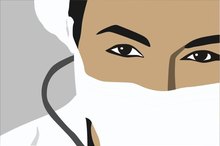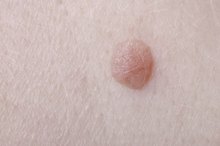Hair Growth From Warts
Warts can be an unsightly problem, and even worse if the wart is accompanied by hair growth. But a hairy wart is relatively common and little cause for concern 2. Warts are usually easily treatable through at-home or in-office medical procedures.
Causes
All warts stem from the same virus: the human papillomavirus, commonly abbreviated to HPV. Warts are a contagious condition, spread through person-to-person contact or through exposure to a surface contaminated with HPV.
Types
Earlobe Wart
Learn More
Warts are typically divided into three types: plantar, dome and flat. Plantar warts occur on the bottom of the feet; dome warts on toes, fingers or knees; and flat warts elsewhere on the body. Although any kind of wart is capable of sustaining hair growth, it's most common with the flat wart type, as these warts are more likely to appear in an area with follicles underlying the skin 12.
Symptoms
Warts generally first appear as a small bump on the skin, growing with time. Hair growth generally occurs in warts left untreated for an extended period, as it takes time for the hair to grow long enough to break through the surface of the wart.
Appearance
Hard Bumps on a Child's Skin
Learn More
Depending on the type, warts may appear as a small to large bump on the surface of the skin with a small black dot in the middle, a capillary that develops to carry blood to the wart. As the wart develops, one or more follicles of hair may grow directly from the surface of the wart. Because the appearance can be similar to an infection caused by an ingrown hair follicle, it's important to get the correct diagnosis of a wart with hair growth before proceeding with treatment.
Treatment
Hair growth from a wart can be trimmed or shaved without concern, although this doesn't eliminate or reduce the appearance of the underlying wart. Over-the-counter treatment with salicylic acid or in-office freezing of a wart by a dermatologist using liquid nitrogen are the two most common ways to kill a wart 2.
Related Articles
References
- Linkroll: Warts with Hair
- Medicine Net: Common Wart
- InformedHealth.org. Warts: Overview. Cologne, Germany: Institute for Quality and Efficiency in Health Care (IQWiG). Updated November 7, 2019.
- InformedHealth.org. What are the treatment options for warts? Cologne, Germany: Institute for Quality and Efficiency in Health Care (IQWiG). Updated November 7, 2019.
- Al Aboud AM, Nigam PK. Wart (Plantar, Verruca Vulgaris, Verrucae). Treasure Island, FL: StatPearls Publishing. Updated September 27, 2019.
- Liu J, Li H, Yang F, et al. Epidemiology and Clinical Profile of Cutaneous Warts in Chinese College Students: A Cross-Sectional and Follow-Up Study. Sci Rep. 2018;8(1):15450. doi:10.1038/s41598-018-33511-x
- Goldman RD. Duct tape for warts in children: Should nature take its course?. Can Fam Physician. 2019;65(5):337-338.
- Cockayne S, Hewitt C, Hicks K, et al. Cryotherapy versus salicylic acid for the treatment of plantar warts (verrucae): a randomised controlled trial. BMJ. 2011;342:d3271. doi:10.1136/bmj.d3271
- Baker DA, Ferris DG, Martens MG, et al. Imiquimod 3.75% cream applied daily to treat anogenital warts: combined results from women in two randomized, placebo-controlled studies. Infect Dis Obstet Gynecol. 2011;2011:806105. doi:10.1155/2011/806105
- Gaston A, Garry RF. Topical vitamin A treatment of recalcitrant common warts. Virol J. 2012;9:21. doi:10.1186/1743-422X-9-21
- Walczuk I, Eertmans F, Rossel B, et al. Efficacy and safety of three cryotherapy devices for wart treatment: A randomized, controlled, investigator-blinded, comparative study. Dermatol Ther (Heidelb). 2018;8(2):203-16. doi:10.1007/s13555-017-0210-5
- Dalimunthe DA, Siregar R, Tanjung C. Comparative clinical efficacy between electrodesiccation with curettage and application of 80% phenol solution in treatment of common warts. Open Access Maced J Med Sci. 2018;6(2):326-9. doi:10.3889/oamjms.2018.074
- Chauhan PS, Mahajan VK, Mehta KS, Rawat R, Sharma V. The efficacy and safety of intralesional immunotherapy with measles, mumps, rubella virus vaccine for the treatment of common warts in adults. Indian Dermatol Online J. 2019;10(1):19-26. doi:10.4103/idoj.IDOJ_142_18
- Nofal A, Elkot R, Nofal E, Mazen M. Combination therapy versus monotherapy in the treatment of recalcitrant warts: A clinical and immunological study. J Cosmet Dermatol. 2018;2018;12848. doi:10.1111/jocd.12848
- Raghukumar S, Ravikumar BC, Vinay KN, et al. Intralesional vitamin D injection in the treatment of recalcitrant warts: A novel proposition. J Cutan Med Surg. 2017;21(4):320-4. doi:10.1177/1203475417704180
Writer Bio
Roger Smith is a journalist with three years of experience working for media outlets including eHow and Answer Bag. He worked on the student paper at the University of Southern California for three years.








